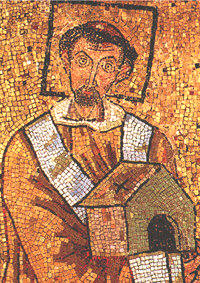 John VII was a Greek of illustrious family. His father, Plato, was a
curator of the imperial palace. He had done much to restore the decaying
palace of the Caesars on the Palatine Hill. John became rector of the
estates of the patrimony of Peter on the Appian Way. He was learned,
eloquent and very devoted to Mary, the Mother of God. He seems, however, to
have been somewhat timid, and timidity was not the quality most desirable
in a pope who had to face the restored Justinian II.
John VII was a Greek of illustrious family. His father, Plato, was a
curator of the imperial palace. He had done much to restore the decaying
palace of the Caesars on the Palatine Hill. John became rector of the
estates of the patrimony of Peter on the Appian Way. He was learned,
eloquent and very devoted to Mary, the Mother of God. He seems, however, to
have been somewhat timid, and timidity was not the quality most desirable
in a pope who had to face the restored Justinian II.
Justinian had been overthrown and, with his nose sliced off, exiled to
Cherson. Now in 705, with the help of the Bulgarians he stole into
Constantinople through an aqueduct and reestablished himself on the throne.
Blood flowed in torrents. The slit-nosed one, as he is termed, was not
gentle. He put out the eyes of Patriarch Callinicus and sent him to Rome.
No doubt the city was filled with horror stories of this Grand Guignol
emperor.
Once his enemies were disposed of, the tenacious Justinian turned his
attention to reviving his pet project--getting the Pope to confirm the
decrees of the Quinisext or Trullan Council. It will be remembered that
only the violent reaction of the Italian soldiers had saved Pope Sergius
from being carried off to Constantinople because he had refused to confirm
these decrees, some of which were highly objectionable. Now Justinian sent
Pope John VII copies of the decrees and a letter in which he urged the Pope
to hold a synod and decide which decrees he could confirm and which he
would reject. This sounds quite reasonable, but Pope John was evidently too
much afraid of Justinian to take the slit-nosed one at his word. He sent
the decrees back unsigned and without comment. And shortly afterwards in
707, he died.
For a wonder, John had more pleasant relations with the Lombards. Aripert
II, king of the Lombards, restored to the Pope the estates of the patrimony
in the Cottian Alps area which had been confiscated years ago in the time
of King Rothari. To confirm this restitution, Aripert sent the Pope a deed
written in golden letters.
It is interesting to note that the English clergy of that day were not
sticklers for propriety in dress. Pope John VII had to rebuke them for
their love of the gay clothes of laymen. John seems to have inherited from
his father, the curator of the palace an interest in restoring buildings.
He restored the Lateran Basilica and had frescoes painted in St. Mary
Antiqua.
Excerpted from "Popes
Through the Ages" by Joseph Brusher, S.J.

